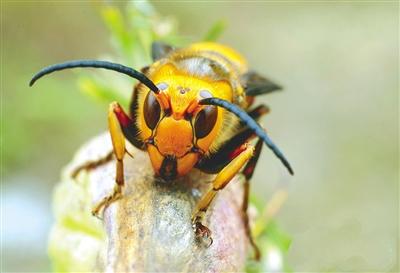30 years after Doctor Cur's fateful African trip, graduate students from the University of Miami are on a field trip exploring caves.
在柯爾博士的非洲之行30年后,邁阿密大學的研究生們正在野外探險洞穴。
Moving ahead of the group, 24-year-old Inn-Saing Ooi climbs into a deep crevasse. He's not alone. As he sweeps his flashlight around the interior of the cave, he startles a huge hive of Killer Bees. And these guys don't like surprises. They quickly retaliate.
走在隊伍前面,24歲的Inn-Saing Ooi爬進了一個深裂縫中。他不是一個人。當他用手電筒掃視洞穴內部時,他驚嚇到,發(fā)現了一大群殺人蜂。這些殺人蜂不喜歡驚喜。他們很快會報復。
Stingers pierce his flesh, injecting venom into his bloodstream. As the bees try to fly away, their stingers are ripped from their abdomen. Defending the hive means certain death. But even without the bee, the stinger keeps pumping venom for as long as a minute. Inn-Saing Ooi quickly slides into a life-threatening condition known as anaphylactic shock. Like all victims, just how quickly depends on the dose of venom and his own sensitivity. Blood pressure plummets to a dangerously low level, his airways constrict. Inn-Saing Ooi's heart rate slows dramatically. In most cases, a shot of adrenalin will jump-start the heart, elevating his blood pressure, saving his life.
毒刺刺穿他的肌肉,將毒液注入他的血液。當蜜蜂試圖飛走時,它們的毒刺會從腹部被撕下來。保衛(wèi)蜂巢就意味著死亡。但即使沒有蜜蜂,毒刺也會持續(xù)分泌一分鐘的毒液。Inn-Saing Ooi很快就陷入了一種致命的過敏性休克。就像所有的受害者一樣,毒液的劑量和他自己的敏感性決定了毒液的傳播速度。血壓驟降到危險的低水平,他的氣道收縮。Inn-Saing Ooi的心率急劇減慢。在大多數情況下,注射一劑腎上腺素會使心臟再次跳動,升高他的血壓,挽救他的生命。

But in an extreme case like this one, there is simply too much toxin for his immune system to handle. Tissue and body functions break down. His kidneys fail.
但在像這樣的極端情況下,太多的毒素讓他的免疫系統(tǒng)無法承受。組織和身體功能崩潰。他的腎臟壞掉。
Inn-Saing Ooi has nowhere to run, each sting sending out a chemical signal to the rest of the hive to keep up the assault.
Inn-Saing Ooi無處可逃,蜂蜜刺一次會向蜂巢的其他蜂蜜發(fā)出化學信號,以保持攻擊。
The young student suffers cardiac arrest and dies. He was stung over 8 thousand times, nearly 8 times the number of stings required to kill a man his size. Tragedies like this have earned these creatures the nickname---- Killer Bees.
這位年輕的學生心臟驟停繼而死亡。他被蟄了8000多次,相當于殺死一個像他這么大的人所需要被蟄次數的8倍。這樣的悲劇為這些生物贏得了“殺人蜂”的綽號。
Despite its fearsome reputation, the killer bee is just a honeybee, a hard-working honeybee that produces some of the sweetest nectarin the world, but a honeybee that will sting its victim 10 times more frequently than its more docile cousin, and it will defend an area nearly 3 times as large. So just how do you tell these bees apart? It turns out you can't. They look almost exactly the same. Even the sting of the Africanized bee is virtually identical to an ordinary bee. It's just the number of Killer Bees who join the fight that makes their attacks so dangerous.
盡管有可怕的名聲,殺人蜂只是一只蜜蜂,勤勞的蜜蜂生產世界上最甜的花蜜,但是一只蜜蜂會比它溫順的表弟更頻繁地蟄它的獵物多十倍,它將保衛(wèi)一個幾乎是它三倍大的區(qū)域。那么如何區(qū)分這些蜜蜂呢?事實證明你不能。它們看起來幾乎完全一樣。即使被非洲化的蜜蜂的刺痛也幾乎和普通蜜蜂一樣。正是這些參與戰(zhàn)斗的殺人蜂的數量讓它們的攻擊變得如此危險。












